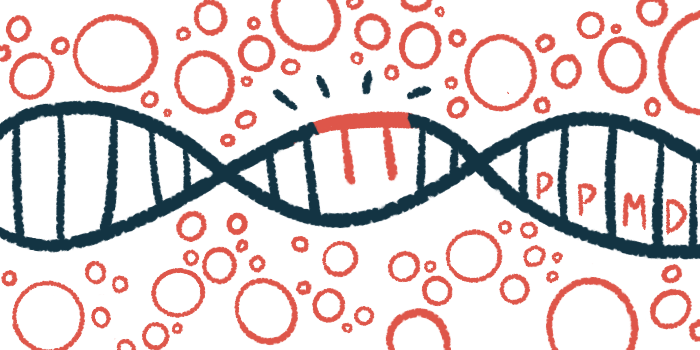PPMD 2024: Gene therapy trials recruiting patients around the world
Multiple trials seeking breakthroughs in DMD gene therapy

With the first gene therapy for Duchenne muscular dystrophy (DMD) now approved in the U.S. for most people with the disease, clinical trials are underway to better understand the safety and efficacy of the approved treatment, find strategies to expand its use, and develop the next generation of DMD gene therapies.
The current and evolving landscape of DMD gene therapies was the topic of discussion during a research row session at last week’s Parent Project Muscular Dystrophy (PPMD) conference, held in Orlando, Florida.
Duchenne is caused by mutations in the gene DMD. As a result of these mutations, patients have virtually no dystrophin protein. Without dystrophin, muscle cells accumulate damage over time, driving disease symptoms. Gene therapy is a therapeutic strategy that aims to deliver a healthy copy of the DMD gene to a patient’s muscle cells, allowing production of functional dystrophin protein to limit disease progression.
Sarepta’s Elevidys is 1st FDA-approved DMD gene therapy
A few weeks ago, Sarepta Therapeutics’ Elevidys (delandistrogene moxeparvovec-rokl) became the first gene therapy to win full approval from the U.S. Food and Drug Administration (FDA) for DMD patients 4 and older who are ambulatory (able to walk). The FDA also okayed Elevidys for nonambulatory patients in the same age range, though that approval is conditional on further data showing the gene therapy benefits people with DMD who cannot walk.
Sarepta is running a Phase 3 trial called ENVISION trial (NCT05881408) to collect data on the use of Elevidys in a wide group of DMD patients of various ages and walking abilities. That study, which Sarepta hopes will serve as confirmation of Elevidys’ efficacy in nonambulatory patients, is still recruiting participants at sites in Italy, Belgium, Spain, the U.K., and Japan.
Participants who have completed ENVISION and earlier studies of Elevidys may transition into a long-term follow-up study called EXPEDITION (NCT05967351), which will track outcomes for up to five years following the gene therapy.
Meanwhile, another study called ENVOL (NCT06128564) is ongoing in Europe to test Elevidys in boys as young than 4 years, who have DMD. That study is sponsored by Roche, which holds rights to Elevidys outside the U.S. The goal of ENVOL is to assess the safety of the gene therapy in these young children, as well as the therapy’s ability to promote expression of dystrophin in muscles as designed.
Elevidys delivers a shortened version of the DMD gene that encodes micro-dystrophin, a miniature version of the dystrophin protein. Like many gene therapies, Elevidys uses a lab-engineered, harmless vector based on an adeno-associated virus (AAV) to deliver its genetic payload. Elevidys cannot be used in patients who have high titers (blood levels) of antibodies against this viral vector, since the antibodies will stop the therapy from working and can increase the risk of problematic side effects.
Sarepta exploring strategies to remove problematic antibodies
Sarepta is currently looking into strategies that could allow Elevidys to be given to patients with pre-existing antibodies. One strategy is plasmapheresis, which is a procedure that basically aims to filter the blood, removing problematic antibodies. Sarepta is planning to start studies testing this in a clinical setting.
Another strategy is to use imlifidase, a drug that’s designed to destroy problematic antibodies. Imlifidase is approved in Europe, under the brand name , to help prevent complications during kidney transplant. A small Phase 1 study (NCT06241950) testing this strategy in half a dozen patients is ongoing in Spain.
Another notable limitation with Elevidys is that it is not recommended for use in people with certain mutations in the DMD gene (specifically deletions in exon 8 and/or exon 9). Patients with these mutations are very likely to have an immune reaction against the gene therapy, where the body’s immune system mistakes the micro-dystrophin for an infectious threat, so immune cells attack muscle cells that have received the therapeutic gene, which can lead to serious problems like difficulty breathing.
Research is ongoing looking for ways to allow patients with these mutations to benefit from gene therapy, which is “an important issue that needs to be addressed,” according to Diana Bharucha-Goebel, MD, PhD, a clinician at Children’s National Hospital who chaired the gene therapy talk at the PPMD conference.
While some researchers are working to better understand Elevidys and expand its use for more patients, others are working to advance the next generation of DMD gene therapies.
Regenxbio’s RGX-202 has unique micro-dystrophin construct
One example is Regenxbio’s RGX-202. Like Elevidys, RGX-202 aims to deliver a gene encoding micro-dystrophin using an AAV vector. But RGX-202 is unique in that its micro-dystrophin construct includes part of the dystrophin protein called the C-terminal domain, which isn’t found in other DMD gene therapies.
The Phase 1/2 AFFINITY DUCHENNE study (NCT05693142) is ongoing to test RGX-202 in boys with DMD up to age 11. Recruitment is ongoing at several U.S. sites, and was recently expanded to include boys as young as 1 year.
Jahannaz Dastgir, senior clinical development lead at Regenxbio, shared interim data from seven participants in the trial. The first three were given a relatively low dose of gene therapy, and the other four were given a higher dose. Safety data have so far revealed no serious side effects, and data have shown dystrophin expression higher than 10% of normal in all treated patients, with a few individuals attaining dystrophin levels upwards of 75% of normal.
Solid Biosciences’ SGT-003 uses novel type of AAV vector
Solid Biosciences is also developing a gene therapy called SGT-003. The company had previously been developing a different gene therapy called SGT-001. The next-generation therapy SGT-003 uses a novel type of AAV vector to deliver its genetic cargo to muscle cells and showed better efficacy in preclinical experiments.
Like Elevidys and RGX-202, SGT-003 also works to deliver a gene encoding a micro-dystrophin construct, but the specific version in SGT-003 has its own unique elements, including a part of the dystrophin protein that’s able to interact with another protein key for muscle health.
The FDA cleared Solid to launch a first-in-human study of SGT-003, with the main goal of evaluating safety. That study, called INSPIRE DUCHENNE (NCT06138639), is actively recruiting boys with DMD, ages 4 to 7, at sites in California and Ohio. To be eligible, patients must be negative for AAV antibodies and have to have mutations in specific regions of the DMD gene (exons 1 to 11 or 42 to 45), among other criteria.
Sardocor’s SRD-001 designed to treat heart disease in DMD
Another up-and-coming gene therapy is Sardocor’s SRD-001, which is specifically being explored to treat cardiomyopathy (heart disease) in DMD. Rather than delivering a gene encoding dystrophin, this gene therapy delivers a gene that encodes SERCA2a, which is a protein that helps regulate cellular calcium levels (problems with calcium levels are a feature of heart disease).
SRD-001 is delivered directly to the heart via a surgical procedure using catheters threaded through large vessels in the arm or legs to reach the heart. Roger Hajjar, MD, president and chief medical officer at Sardocor, noted that this type of procedure is very common: “It’s a procedure done thousands of times a day across the U.S.,” he said.
Sardocor recently launched a clinical trial called MUSIC-DMD (NCT06224660) to test the safety of SRD-001 in adults with DMD-related cardiomyopathy. The trial, which has not yet begun to recruit participants, will also explore the therapy’s effect on markers of heart health.
Collectively, these studies hold promise to shed new light on the use of gene therapy and make this exciting new treatment strategy available to more and more patients.
Note: The Muscular Dystrophy News Today team is providing virtual coverage of the Parent Project Muscular Dystrophy Annual Conference (PPMD) June 27-29. Go here to see the latest stories from the conference.










